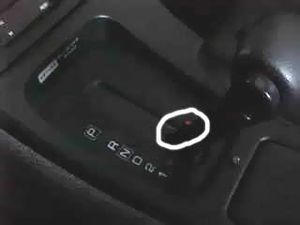Automatic Transmission Diagnostics
Revision as of 21:55, 5 April 2018 by Maintenance script (talk | contribs) (Imported from text file)
The Z32's automatic transmission is a pretty good one for it's era, but it's not without faults. If your transmission is shifting hard, early, late, or just acting funny, a good starting point is to run codes. Just like one would do for your ECU, the Automatic Transmission Control Unit (colloquially called the Auto ECU) can run self-diagnostics to indicate faults.
Source: http://diy.icydesigns.com/article/146/Nissan/300ZX/Z32_(1990-96)/Transmission/Automatic/Transmission:_Automatic_Transmission_Diagnostic/
Procedure
- Ensure the engine is at operating temperature, in P (Park) with the Overdrive switch on.
- Start the engine. The A/T Light should go out after about 2 seconds.

- Turn the engine off.
- Switch the transmission to D (Drive), either by using the brake pedal or the release switch (pictured below).

- Set the overdrive switch to Off.
- Wait 2 seconds, then switch the Ignition switch ON.
- Wait 2 seconds, then move the shifter to "2."
- Set overdrive switch ON.
- Move the shifter to "1."
- Set overdrive switch OFF.
- Fully depress accelerator pedal, then release it.
- The codes will start flashing. The first long flash signifies the start of the code sequence, followed by 10 short flashes. All 10 flashes the same duration indicates no problems. To display a code, one of the 10 short flashes will be longer in duration than the others.
Codes
- All 10 flashes the same = No error codes detected.
- 1st flash longer than others = Revolution sensor is shorted or disconnected.
- 2nd flash longer than others = Speed sensor circuit is shorted or disconnected.
- 3rd flash longer than others = Throttle sensor circuit is shorted or disconnected.
- 4th flash longer than others = Shift solenoid "A" circuit is shorted or disconnected
- 5th flash longer than others = Shift solenoid "B" circuit is shorted or disconnected
- 6th flash longer than others = Overrun clutch solenoid circuit is shorted or disconnected
- 7th flash longer than others = Lock-up solenoid circuit is shorted or disconnected
- 8th flash longer than others = Fluid temperature sensor is disconnected or A/T control unit power source circuit is damaged.
- 9th flash longer than others = Engine revolution signal circuit is shorted or disconnected
- 10th flash longer than others = Line pressure solenoid circuit is shorted or disconnected
- All the same with no long start flash = Battery low, been disconnected, or control unit has just been reconnected.
Source: http://diy.icydesigns.com/article/146/Nissan/300ZX/Z32_(1990-96)/Transmission/Automatic/Transmission:_Automatic_Transmission_Diagnostic/